Dallas
event guy
- Joined
- Apr 26, 2016
- Messages
- 14,291
- Nebulae
- 81,052

THE SAGA - PART IV

Kungariket Sverige
KINGDOM OF SWEDEN 1648
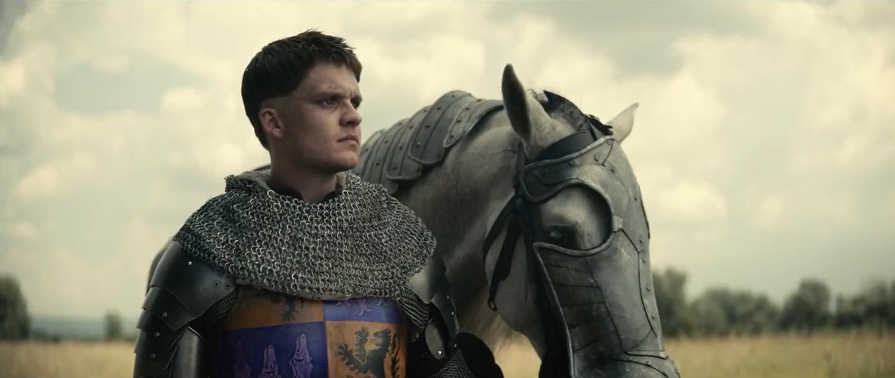
GUSTAV IX SJÖBLAD
-THE PIOUS-
♱
The Imperial Duchy of Sweden remained a loyal servant to the ambitions of the emperor in Prussia. For the decades following 1594, Sweden remained at peace with the outside world - instead its only wars were internal, fought against its own people. The so-called sacred war against the Lutheran and Catholic subjects of his lands was Gustav's greatest task in life - he was driven, as if possessed, to drive out non-believers. So fervent was he in this act that many thousands were put to the sword, many converts were slain still, so that their souls may find an immediate salvation. For decades, the country roiled in religious pandemonium, with scarce word reaching allies outside the empire; the King of Italy, the Tsar of Russia, the British Emperor, all had only faint ideas of the chaos burning through the Swedish hinterland.
During this time, a series of Prussian-style reforms strengthened the Swedish army; drilling and training on Jutland, the de-facto seat of Gustav's power, away from the Lutheran and often violent capital of Stockholm. The unrest would peak in 1610, when the nobility revolted against the ruling Sjöblad dynasty; eager to depose the tyrant Gustav with another noble house. These rebels were joined by Finnish and Norwegian lords seeking greater regional autonomy from the centralising Swedish court.
There would be several more years of conflict, culminating in the destruction of rebel forces at the Battle of Karlstad in 1616. The punitive laws of the Dyklan were upheld - the Swedish wars of religion were ended.
It would be in 1630 that Gustav would once again break with longstanding Swedish foreign policy and intervene in yet another conflict at behest of the emperor - to reclaim the Germanic lands of Austria and Switzerland, currently occupied by the Kingdom of Italy.
Gustav was marshaling troops in Jutland, preparing for the invasion, when he died of a mysterious illness.
Having lived a life of pious celibacy, he fathered no children. The only remaining Sjöblad heir, Gustav's nephew Karl Andreassen, was 9 years old old.
In 1631, a regency council, the Council of Skåne, established its control over the country.
♱

THE COUNCIL OF SKÅNE
♱
Ruling through the 1630s, the Council of Skåne was an unfocused, bickering council of Swedish elites loyal to the Sjöblad dynasty - although many of them held their own personal ambitions to usurp the young prince Karl, who grew up in the isolation and safety of Trondheim Castle, far from the seat of power in Stockholm.
The Council quickly sought to undo the damage caused by Gustav the Pious; attempting a failed rapprochement with Britain and France, while seeking to distance themselves from the emperor's increasingly tyrannical designs of a unified Holy Roman Empire.
In all these, and more, the Council failed. It reluctantly committed troops to reclaim the Swiss-Germanic and Austrian lands from Italy, pressured by Berlin. During this intervention, the Revocation of the Privilegia was passed whereby the emperor claimed supremacy as the head of state for all members of the Holy Roman Empire. In effect, this was unification - and total service to the Kaiser now seemed a certainty for all who remained in the empire. The Council debate long into the night of August 12th, 1436 - the night that would change the fate of Sweden. How they wished for a saviour among them, a Fredrick the Great, who would lead them to victory through luck, diplomacy or skill.
But there was no easy way out of this, and the Council were composed of ordinary mortals - not the divine rulers that Europe had based its history on.
The Kingdom of Sweden was proclaimed once more - an independent nation outside the Holy Roman Empire. Although still tied to Prussia through treaty, this move would permanently damage relations between the two.
Karl X ascended to the throne in 1640, he would dissolve the Council of Skåne after his coronation.
♱
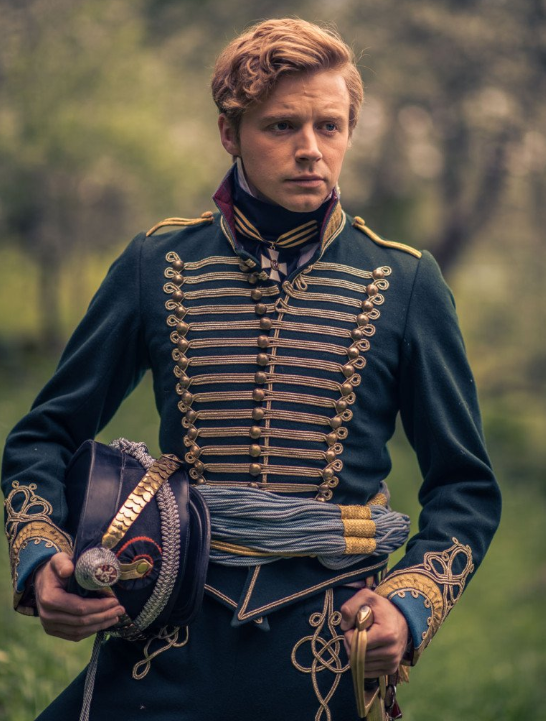
KARL X SJÖBLAD
-WARRIOR KING-
♱
Young Karl X inherited his realm, much like his predecessors, at a time of chaos. The world hurtled inexoribly towards full scale conflict between the great powers. His early rule saw the Prussian Kaiser crush Italy and France, forcing the global power - the British Empire - to refrain from continental intervention. The power and sheer forces at the command of the Kaiser were terrifying.
Furthermore, Karl could no longer count of the aid of the Russians - who were now embroiled in a decade-long struggle against the Ottoman Empire. The two titans fought on, isolated from the rest of the world, in a duel that would decide the fate of the east.
Sweden could rely on no one for assistance. So when a demand came from Emperor Friedrich-Wilhelm for the Danish province of Slesvig, Karl had to choose between war and peace. Would he desert his subjects and abandon sovereign land, his Scandinavian brothers, to the German emperor? Would his country be doomed to live as a slave state forever?
Karl rejected the demand. The emperor declared a war of imperial conquest, summoning dozens of subjects to mobilize and invade the Swedish realm.
In the opening week of hosilities, Karl was able to pull his armies across from Jutland and back towards Sweden, understanding the impossible numbers he was facing he judged that only targeting individual vassal armies could secure him time for Prussia's enemies to strike back against the empire. Karl hoped that the eastern empires would put aside their fighting over Black Sea territories, but no response came.
In the winter of 1640, Copenhagen fell to the Prussians. The emperor assembled his forces across the belts, ready to invade Skåne and bring ruin to the Swedish hinterland. Then - through the mists of the December morning the Kaiser planned to attack, the British fleet sailed to Sweden's defence, smashing the imperial navy and buying the Swedish army, now 80,000 strong, time to organise a counterattack. Far across the Baltic, the lesser lords of the empire had seiged and taken the Finnish frontier and were now circling over the Sami territories, above the Arctic Circle, towards the south.
Among these Germanic slave states, there was their master - the Kaiser's army of Konigsburg, one of the fiercest formations in Europe. They would be met in Hälsingland in June of 1641, to make battle under the midnight sun. The Battle of Hälsingland was fought in several engagements as the chaotic bands of German armies struggled to move south in their formations - many of them falling to coordinated Swedish counterattacks and ambushes. The largest of these engagements would come at a field outside of Harmånger, a village situated near the coast from where the Germans were being sporadically resupplied.
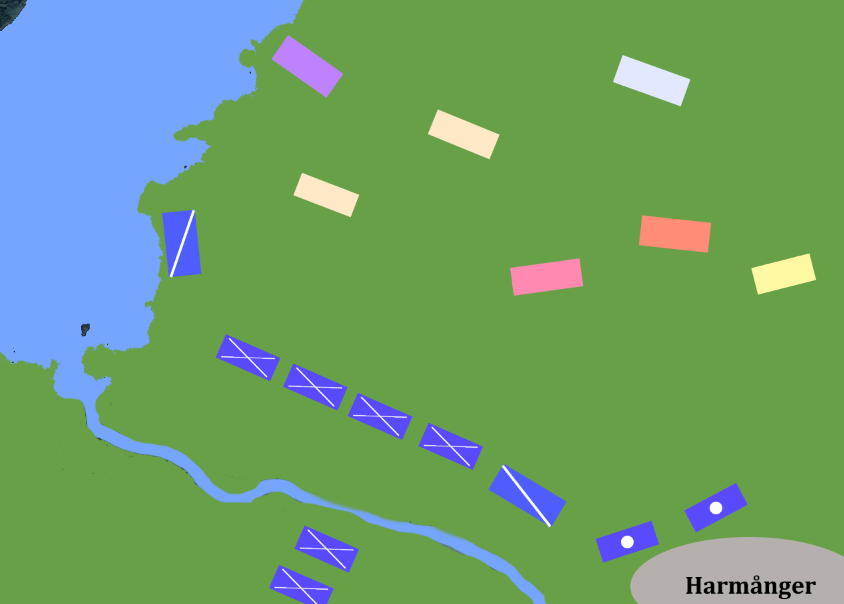
Although met by equal numbers, the petty princes of the empire, exhausted and lacking proper supply, all charged south in broken formation, eager to loot any settlements before the others to keep their armies fed - and to reach the prize of Stockholm first. Karl knew that somewhere behind this mass of Germanics was the Prussian army, advancing its way south, unbroken, ready to make organised and highly tactical maneuvers against the Swedes. Karl knew that if his army had weaknesses then it was the Prussian who knew how to exploit them - they had trained them after all.
The Swedish host opted for aggression, striking north into the clusters of disorganised German units, forcing them into the open clearing ahead of the main line of attack, before closing in around the Germans with their cavalry and reserve soldiers.

An encirclement appeared to be developing successfully - the Germans were all but totally cut off from escape. Karl ordered his artillery to advance north, attempting to bring it towards the fight. At this point, late into the evening, the midnight sun shone down on the exhausted hosts, fighting for their lives in the wetlands, plains and forests of the battlefield. The fighting was most intense in the kessel - the cauldron of Germans who were trapped. Karl was at most an hour away from total victory, a modern day Cannae.
And then the Prussians emerged from the woods to the north. Locked in step, marching south, ready to break the Swedish encirclement. Karl wheeled his artillery to fire on the advancing Prussian army, and try to form a new line of battle, but it was too late...
At the sight of the Prussian reinforcement, many lost heart, regiments broke and fled the field. The Germans, who charged back towards their lines, were mown down by waves of Prussian fire - killing Swedes and imperial subjects alike, the slaughter was complete and indiscriminate.
Before anyone could make the order official, Karl's army was in full retreat back towards the river, pursued by the Prussian army.
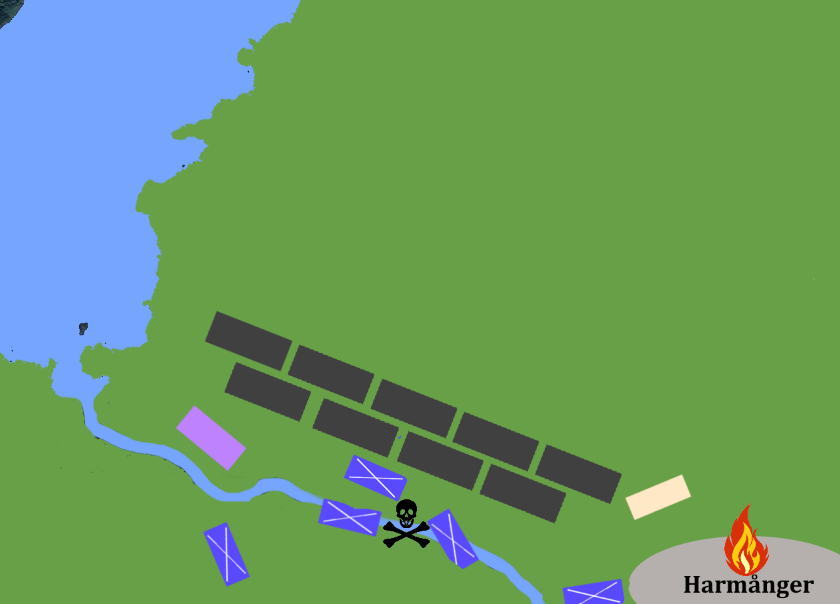
The crossing of the river Strumbroksvagen was the only natural barrier standing in the way of what could have been an orderly retreat - instead it became total chaos. The shallow ford through which the army had crossed was missed by several regiments; hundreds of soldiers drowned in the failed attempts to ford the fast flowing river, while others fled in the direction of the town - burning from the Prussian artillery fire. What little German support survived the Prussian advance now stayed clear of the main host, instead hunting down the stragglers, or looting the village for what food or valuables they could.
Karl hoped to reorganise his force on the far side of the river; he called for his marshals and managed to scrape together enough cover to ford at the correct crossing, and was about to signal that the rear guard follow when a Prussian sharpshooter stuck the King in the chest - he fell from his horse and was dragged from the field of battle.
In total, the Battle of Hälsingland resulted in 32,000 German causalities and 37,000 Swedish casualties.
The Swedes were defeated. Karl succumbed to his wounds as dawn broke the next day.
The last heir to the Sjöblad bloodline was dead.
Sweden avoided total defeated in the end - the Treaty of Holstein allowed Swedish independence from the empire to continue, subject to a neutrality clause limiting all foreign affairs with an expiry date of 99 years. In addition, Slesvig was lost - ceded to the Holy Roman Emperor in perpetuity.
♱
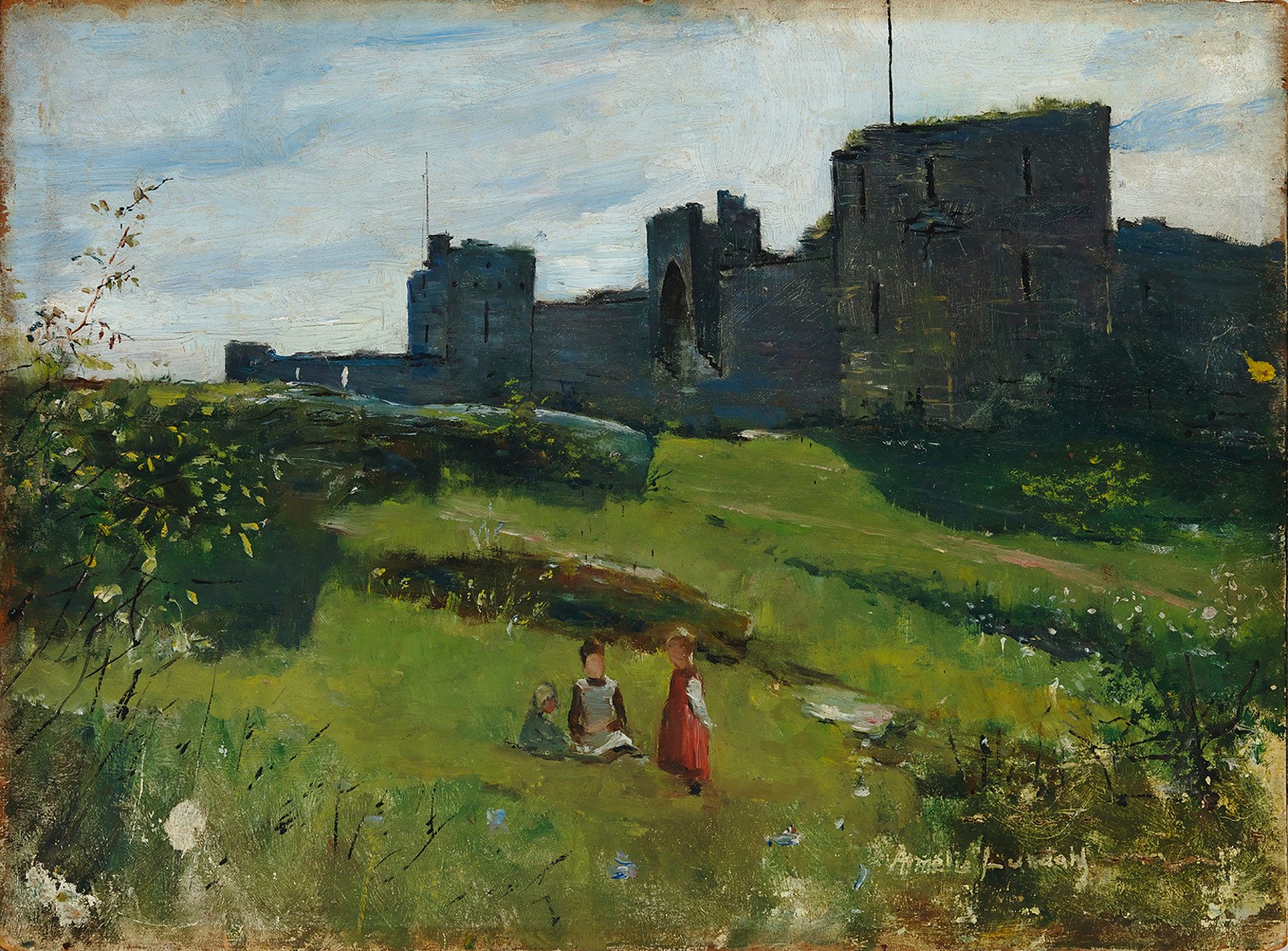
THE REPUBLIC OF SCANDINAVIA
-Republiken Skandinavien-
♱
Following the end of the Swedish-Prussian War, there was a period of council regency that lasted several decades. The leader of this council was Johan Erikssen, a direct descendant of the Swedish noble Johan I, the Duke of Gotland.
Through a series of compassionate, modernising reforms, Sweden transitioned into the Realm of Scandinavia; it increased the powers of the Riksdag, ended the tyrannical Dyklan laws, restored the rights of the Sami and Fins, while also embracing a new role in Europe - diplomatic, cultural, a centre of European arts and science. The northern republic would lead the world in championing the abolition of slavery and welcomed refugees from the wars of religion and their persecuted descendants.
Finally, in 1677, inspired by the success of the United States of America, Johan declared Scandinavia a republic, formally ending decades of parliament-regency rule.
The new Scandinavian state was a decentralised confederation, with individual regional assemblies granted to Norway, Denmark, Sweden and Finland - with Sami assemblies acquiring legislative powers in the late 18th century.
This confederation of equal states had no single capital, but multiple - yet its highest federal courts and parliament, the Riksdag, was moved to a site of symbolic meaning in the story of these northern kingdoms, these arctic peoples.
Visby, on the island of Gotland, hosts the Skandinavien Riksdag.
Johan I and his descendants are seen as the founders of the modern Scandinavian nation.
Sweden's experiment with monarchy would come to be regarded as an unwise mistake, a venture in absolutism that brought only pain and strife to the realm. The Sjöblads, for all their skill and cunning, were a cruel and unsuccessful dynasty that ultimately failed Sweden, and all of Scandinavia.
In the end, the terror had to end - and only brotherhood endured to bind these nations together. Love for country, and compassion for the people, holds this land together now against the tides of history.
♱

The flag of the modern day Republic of Scandinavia.
♱
KINGDOM OF SWEDEN 1648

GUSTAV IX SJÖBLAD
-THE PIOUS-
♱
The Imperial Duchy of Sweden remained a loyal servant to the ambitions of the emperor in Prussia. For the decades following 1594, Sweden remained at peace with the outside world - instead its only wars were internal, fought against its own people. The so-called sacred war against the Lutheran and Catholic subjects of his lands was Gustav's greatest task in life - he was driven, as if possessed, to drive out non-believers. So fervent was he in this act that many thousands were put to the sword, many converts were slain still, so that their souls may find an immediate salvation. For decades, the country roiled in religious pandemonium, with scarce word reaching allies outside the empire; the King of Italy, the Tsar of Russia, the British Emperor, all had only faint ideas of the chaos burning through the Swedish hinterland.
During this time, a series of Prussian-style reforms strengthened the Swedish army; drilling and training on Jutland, the de-facto seat of Gustav's power, away from the Lutheran and often violent capital of Stockholm. The unrest would peak in 1610, when the nobility revolted against the ruling Sjöblad dynasty; eager to depose the tyrant Gustav with another noble house. These rebels were joined by Finnish and Norwegian lords seeking greater regional autonomy from the centralising Swedish court.
There would be several more years of conflict, culminating in the destruction of rebel forces at the Battle of Karlstad in 1616. The punitive laws of the Dyklan were upheld - the Swedish wars of religion were ended.
It would be in 1630 that Gustav would once again break with longstanding Swedish foreign policy and intervene in yet another conflict at behest of the emperor - to reclaim the Germanic lands of Austria and Switzerland, currently occupied by the Kingdom of Italy.
Gustav was marshaling troops in Jutland, preparing for the invasion, when he died of a mysterious illness.
Having lived a life of pious celibacy, he fathered no children. The only remaining Sjöblad heir, Gustav's nephew Karl Andreassen, was 9 years old old.
In 1631, a regency council, the Council of Skåne, established its control over the country.
♱

THE COUNCIL OF SKÅNE
♱
Ruling through the 1630s, the Council of Skåne was an unfocused, bickering council of Swedish elites loyal to the Sjöblad dynasty - although many of them held their own personal ambitions to usurp the young prince Karl, who grew up in the isolation and safety of Trondheim Castle, far from the seat of power in Stockholm.
The Council quickly sought to undo the damage caused by Gustav the Pious; attempting a failed rapprochement with Britain and France, while seeking to distance themselves from the emperor's increasingly tyrannical designs of a unified Holy Roman Empire.
In all these, and more, the Council failed. It reluctantly committed troops to reclaim the Swiss-Germanic and Austrian lands from Italy, pressured by Berlin. During this intervention, the Revocation of the Privilegia was passed whereby the emperor claimed supremacy as the head of state for all members of the Holy Roman Empire. In effect, this was unification - and total service to the Kaiser now seemed a certainty for all who remained in the empire. The Council debate long into the night of August 12th, 1436 - the night that would change the fate of Sweden. How they wished for a saviour among them, a Fredrick the Great, who would lead them to victory through luck, diplomacy or skill.
But there was no easy way out of this, and the Council were composed of ordinary mortals - not the divine rulers that Europe had based its history on.
The Kingdom of Sweden was proclaimed once more - an independent nation outside the Holy Roman Empire. Although still tied to Prussia through treaty, this move would permanently damage relations between the two.
Karl X ascended to the throne in 1640, he would dissolve the Council of Skåne after his coronation.
♱

KARL X SJÖBLAD
-WARRIOR KING-
♱
Young Karl X inherited his realm, much like his predecessors, at a time of chaos. The world hurtled inexoribly towards full scale conflict between the great powers. His early rule saw the Prussian Kaiser crush Italy and France, forcing the global power - the British Empire - to refrain from continental intervention. The power and sheer forces at the command of the Kaiser were terrifying.
Furthermore, Karl could no longer count of the aid of the Russians - who were now embroiled in a decade-long struggle against the Ottoman Empire. The two titans fought on, isolated from the rest of the world, in a duel that would decide the fate of the east.
Sweden could rely on no one for assistance. So when a demand came from Emperor Friedrich-Wilhelm for the Danish province of Slesvig, Karl had to choose between war and peace. Would he desert his subjects and abandon sovereign land, his Scandinavian brothers, to the German emperor? Would his country be doomed to live as a slave state forever?
Karl rejected the demand. The emperor declared a war of imperial conquest, summoning dozens of subjects to mobilize and invade the Swedish realm.
In the opening week of hosilities, Karl was able to pull his armies across from Jutland and back towards Sweden, understanding the impossible numbers he was facing he judged that only targeting individual vassal armies could secure him time for Prussia's enemies to strike back against the empire. Karl hoped that the eastern empires would put aside their fighting over Black Sea territories, but no response came.
In the winter of 1640, Copenhagen fell to the Prussians. The emperor assembled his forces across the belts, ready to invade Skåne and bring ruin to the Swedish hinterland. Then - through the mists of the December morning the Kaiser planned to attack, the British fleet sailed to Sweden's defence, smashing the imperial navy and buying the Swedish army, now 80,000 strong, time to organise a counterattack. Far across the Baltic, the lesser lords of the empire had seiged and taken the Finnish frontier and were now circling over the Sami territories, above the Arctic Circle, towards the south.
Among these Germanic slave states, there was their master - the Kaiser's army of Konigsburg, one of the fiercest formations in Europe. They would be met in Hälsingland in June of 1641, to make battle under the midnight sun. The Battle of Hälsingland was fought in several engagements as the chaotic bands of German armies struggled to move south in their formations - many of them falling to coordinated Swedish counterattacks and ambushes. The largest of these engagements would come at a field outside of Harmånger, a village situated near the coast from where the Germans were being sporadically resupplied.

Although met by equal numbers, the petty princes of the empire, exhausted and lacking proper supply, all charged south in broken formation, eager to loot any settlements before the others to keep their armies fed - and to reach the prize of Stockholm first. Karl knew that somewhere behind this mass of Germanics was the Prussian army, advancing its way south, unbroken, ready to make organised and highly tactical maneuvers against the Swedes. Karl knew that if his army had weaknesses then it was the Prussian who knew how to exploit them - they had trained them after all.
The Swedish host opted for aggression, striking north into the clusters of disorganised German units, forcing them into the open clearing ahead of the main line of attack, before closing in around the Germans with their cavalry and reserve soldiers.

An encirclement appeared to be developing successfully - the Germans were all but totally cut off from escape. Karl ordered his artillery to advance north, attempting to bring it towards the fight. At this point, late into the evening, the midnight sun shone down on the exhausted hosts, fighting for their lives in the wetlands, plains and forests of the battlefield. The fighting was most intense in the kessel - the cauldron of Germans who were trapped. Karl was at most an hour away from total victory, a modern day Cannae.
And then the Prussians emerged from the woods to the north. Locked in step, marching south, ready to break the Swedish encirclement. Karl wheeled his artillery to fire on the advancing Prussian army, and try to form a new line of battle, but it was too late...
At the sight of the Prussian reinforcement, many lost heart, regiments broke and fled the field. The Germans, who charged back towards their lines, were mown down by waves of Prussian fire - killing Swedes and imperial subjects alike, the slaughter was complete and indiscriminate.
Before anyone could make the order official, Karl's army was in full retreat back towards the river, pursued by the Prussian army.

The crossing of the river Strumbroksvagen was the only natural barrier standing in the way of what could have been an orderly retreat - instead it became total chaos. The shallow ford through which the army had crossed was missed by several regiments; hundreds of soldiers drowned in the failed attempts to ford the fast flowing river, while others fled in the direction of the town - burning from the Prussian artillery fire. What little German support survived the Prussian advance now stayed clear of the main host, instead hunting down the stragglers, or looting the village for what food or valuables they could.
Karl hoped to reorganise his force on the far side of the river; he called for his marshals and managed to scrape together enough cover to ford at the correct crossing, and was about to signal that the rear guard follow when a Prussian sharpshooter stuck the King in the chest - he fell from his horse and was dragged from the field of battle.
In total, the Battle of Hälsingland resulted in 32,000 German causalities and 37,000 Swedish casualties.
The Swedes were defeated. Karl succumbed to his wounds as dawn broke the next day.
The last heir to the Sjöblad bloodline was dead.
Sweden avoided total defeated in the end - the Treaty of Holstein allowed Swedish independence from the empire to continue, subject to a neutrality clause limiting all foreign affairs with an expiry date of 99 years. In addition, Slesvig was lost - ceded to the Holy Roman Emperor in perpetuity.
♱

THE REPUBLIC OF SCANDINAVIA
-Republiken Skandinavien-
♱
Following the end of the Swedish-Prussian War, there was a period of council regency that lasted several decades. The leader of this council was Johan Erikssen, a direct descendant of the Swedish noble Johan I, the Duke of Gotland.
Through a series of compassionate, modernising reforms, Sweden transitioned into the Realm of Scandinavia; it increased the powers of the Riksdag, ended the tyrannical Dyklan laws, restored the rights of the Sami and Fins, while also embracing a new role in Europe - diplomatic, cultural, a centre of European arts and science. The northern republic would lead the world in championing the abolition of slavery and welcomed refugees from the wars of religion and their persecuted descendants.
Finally, in 1677, inspired by the success of the United States of America, Johan declared Scandinavia a republic, formally ending decades of parliament-regency rule.
The new Scandinavian state was a decentralised confederation, with individual regional assemblies granted to Norway, Denmark, Sweden and Finland - with Sami assemblies acquiring legislative powers in the late 18th century.
This confederation of equal states had no single capital, but multiple - yet its highest federal courts and parliament, the Riksdag, was moved to a site of symbolic meaning in the story of these northern kingdoms, these arctic peoples.
Visby, on the island of Gotland, hosts the Skandinavien Riksdag.
Johan I and his descendants are seen as the founders of the modern Scandinavian nation.
Sweden's experiment with monarchy would come to be regarded as an unwise mistake, a venture in absolutism that brought only pain and strife to the realm. The Sjöblads, for all their skill and cunning, were a cruel and unsuccessful dynasty that ultimately failed Sweden, and all of Scandinavia.
In the end, the terror had to end - and only brotherhood endured to bind these nations together. Love for country, and compassion for the people, holds this land together now against the tides of history.
♱

The flag of the modern day Republic of Scandinavia.
♱
cheers pals see yous in emperor x
Last edited:
Reactions:
List
